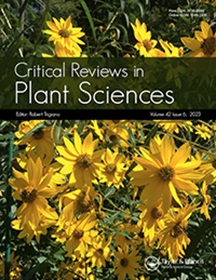花青素的内、外源调控研究进展——真双子叶植物颜色变化的关键
IF 4.9
2区 生物学
Q1 PLANT SCIENCES
引用次数: 0
摘要
摘要花青素是一种重要的水溶性色素,广泛存在于植物中,决定植物器官的颜色,具有重要的保健和经济价值。花青素生物合成途径已经建立,控制该途径的一些关键调节因子已经在多种物种中被鉴定。近年来,微小RNA、转录因子和外部因素,包括光照、温度和激素,已成为包括花青素代谢在内的各种次生代谢反应的中心调节因子,既是植物自我调节因子,也是刺激植物发育的环境信号。许多发现已经开始提出基因/信号基因模块,以揭示果实成熟过程中花青素生物合成的信号通路以及特定基因之间的联系。本文综述了调控真双子叶植物花青素生物合成和积累的内外因素及其相关网络机制。miRNA通过与靶基因结合形成调控模块,对不同物种花青素的生物合成具有不同的影响。这篇综述还集中在以下结论上:光信号(光质量、光周期和光强度)通过与相应的光感受器(UVR8、CRYs和PHY)结合,并影响光通路的中央调节因子(如COP1和转录因子HY5)的结合和稳定,进一步调节花青素的积累。本文旨在为今后研究花青素的有效途径调控提供参考,为新品种的选育和栽培设施的改进做出贡献。本文章由计算机程序翻译,如有差异,请以英文原文为准。
Advances in the endogenous and exogenous regulation of anthocyanins–the key to color change in eudicots
Abstract Anthocyanins are important water-soluble pigments that are widely found in plants and determine the color of plant organs, which possess significant health and economic value. The anthocyanin biosynthetic pathway is well established and some key regulators controlling this pathway have been identified in a variety of species. In recent years, microRNAs, transcription factors, and external factors, including light, temperature and hormones have emerged as central regulators of a variety of secondary metabolic responses, including anthocyanin metabolism, as both plant self-regulatory factors and environmental signals that stimulate plant development. Many discoveries have begun to suggest gene/signal-gene modules to reveal the signaling pathways involved in anthocyanin biosynthesis during fruit ripening and the links between specific genes. This paper reviews the internal and external factors and associated network mechanisms that regulate anthocyanin biosynthesis and accumulation in eudicots plants. miRNAs have different effects on the biosynthesis of anthocyanins in different species by binding to their target genes to form regulatory modules. The review also focuses on the conclusion that light signals (light quality, photoperiod, and light intensity) further regulate anthocyanin accumulation by binding to their corresponding photoreceptors (UVR8, CRYs, and PHYs) and affecting the binding and stabilization of the central regulators of the light pathway, such as COP1 and the transcription factor HY5. This article aims to provide a reference for future research on the regulation of anthocyanin by effective pathways, and to contribute to the selection of new varieties and the improvement of cultivation facilities.
求助全文
通过发布文献求助,成功后即可免费获取论文全文。
去求助
来源期刊
CiteScore
12.90
自引率
1.40%
发文量
15
审稿时长
>12 weeks
期刊介绍:
Critical Reviews in Plant Sciences focuses on presenting in-depth and up-to-date reviews of timely and/or cutting-edge subjects in the broad discipline of plant science, ranging from molecular biology/biochemistry through the areas of cell biology, plant pathology and physiology, genetics, classical botany, and ecology, to practical agricultural applications. Articles in the journal provide an up-to-date literature base for researchers and students, pointing the way towards future research needs. The journal is also a significant source of credible, objective information to aid decision makers at all levels.

 求助内容:
求助内容: 应助结果提醒方式:
应助结果提醒方式:


